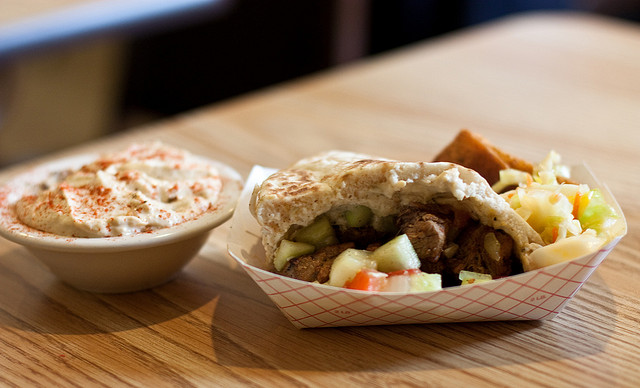Check the Pulse(s) of Your Food Delivery Orders: New Study Shows How to Feel Fuller Longer
Posted by Sara on Thursday, August 7th, 2014 with 5 Comments
During a long work day, your lunch break should accomplish two things: it should provide a much-needed break from your computer screen, clients, or piles of papers, and it should include a meal that leaves you feeling satisfied and re-energized for the rest of the day. But, too many times, we chow down on brown-bag lunches or food delivery orders that don’t get the job done– even when we try to eat healthy foods. If you’re feeling hungry and craving a snack by mid-afternoon, it might be time to rethink your lunch.
A new study published in the journal Obesity, conducted at the Clinical Nutrition and Risk Factor Modification Centre at St. Michael’s Hospital in Toronto, might have the answer: pulses.
While the term might be unfamiliar, you’ve probably eaten lots of pulses in the past! Pulses are a certain classification of legume that includes lentils, chickpeas, and several kinds of beans. Their secret dietary power is they are healthy– not heavy. Eating more pulses can help you feel full!

Pulses can be found in all kinds of dishes – like falafel and hummus, both made from chickpeas.
Image source: flickr user neilconway
In the new study, which was a meta-analysis of previously-conducted clinical studies, researchers found that eating an average of one cup of pulses in a meal increased acute satiety– the scientific way of saying, “feeling full”– by 31 percent, compared to participants who didn’t eat any pulses. That’s a sizable difference, especially considering pulses are incredibly good for you. They’re high in protein and fiber, and most pulses are also rich sources of iron, magnesium, and vitamin B-6.
Eating pulses doesn’t make you feel fuller in the way eating a giant plate of pasta makes you feel fuller. The serving isn’t huge or heavy, but pulses rank low on the glycemic index, which means they take longer to break down and digest. Their very composition makes them the perfect food for filling up without overeating– a huge plus if you’re watching your weight.
So how can you include more pulses to your food delivery orders and mid-day meals at the office? Let’s count the ways:
Lentils
Perhaps the most versatile pulse, you’ll find lentils in all kinds of dishes– especially at establishments that cater to vegetarians. Of course, Indian restaurants are easy– lentils have been integral to Indian cuisine for thousands of years, and the staple dish dal is simply lentils stewed into a spicy porridge. Otherwise, look for lentil soup, veggie burgers made from lentils and brown rice and even lentil Bolognese at vegetarian-friendly Italian restaurants.
Chickpeas
Garbanzo beans and chickpeas are the same things, and you’ll find them everywhere: chana masala (curried chickpeas), hummus, falafel, and summery salads of all kinds.
Kidney & pinto beans
Kidney and pinto beans are the most common pulses in the bean family, and there’s no better place to find them than in a cup of vegetarian chili. Again, Indian restaurants are another good option– look for rajmah chawal. At the deli, a three-bean salad usually includes kidney beans (and possibly chickpeas as well).
Mung beans
Less common but a good change of pace, little green mung beans are used in Indian cuisine (look for mung dal) and star in a delicious stew from the Philippines, ginisang monggo.
Pigeon peas
A staple in some Caribbean and African cooking, pigeon peas may be most easily found in the Puerto Rican dish arroz con gandules: a special-occasion meal made with rice, pigeon peas, pork, and sofrito.
Black-eyed peas
In addition to traditional Southern sides, black-eyed peas are also used in lobia masala– you guessed it, another Indian curry!
As you can see, pulses can be a part of all kinds of meals, from swapping your fries for a cup of chili to ordering a vegetarian lunch from an Indian restaurant! Want to make pulses part of your food delivery routine? Check out the myriad menus available at Waiter.com and find the perfect dish for your next satisfying office lunch!
When it comes to feeding employees and coworkers, make your company's food program really count! If your workplace dining plan needs to take it up a notch — or if you don't have one at all — Waiter.com is here to help. From Virtual Cafeteria Service to diverse menus to local takeout & delivery, Waiter.com offers customizable dining solutions for every business and budget. Contact us today to get started!

This is something I’ve personally done since I’ve gotten into the habit of eating healthy. I can attest that pulses are, in fact, an effective way to stay the hunger.
It makes sense, really. These “pulses” will give you a nice bit of protien without the heaviness of meats. I could definitely go for some hummus at lunch!
Thanks Lydia! I can usually go for some hummus ANY time 🙂
I’m so pleased to have this information now. I typically take a lunch to work and it always seems to vary whether I want an afternoon snack or not (which unfortunately is usually a candy bar from the snack machine). But I do remember a few weeks ago when we had a lot of leftover lentil soup so I ate that every day that week. In retrospect, I never once needed to snack in the afternoons and now I know why. It’s funny how something can be so obvious but you don’t see it until someone spells it out for you. Thanks so much for the informative post!
Glad to be of service John! Lentil soup is an awesome addition to any meal!